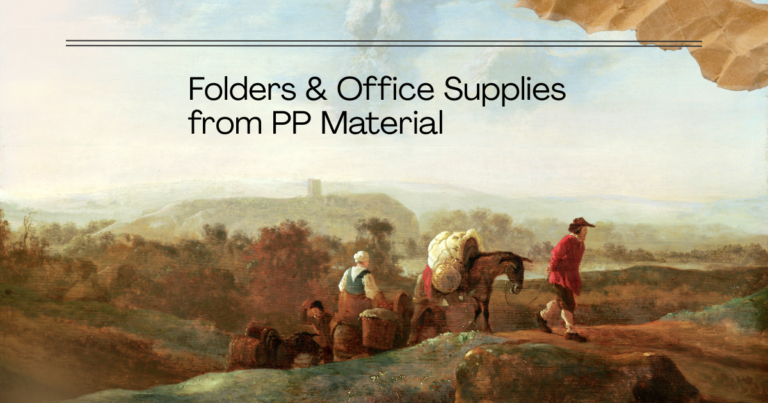Why the Physical Portfolio Still Matters in Present
While digital portfolios are convenient, physical presentations remain powerful in the eyes of professionals. They offer a tactile, curated experience that communicates attention to detail and professionalism. A well-prepared physical portfolio can instantly elevate how your work is received.
Tangible Work Shows Craftsmanship and Authenticity
A physical portfolio gives viewers something digital files cannot—a real sense of the artist’s craft. The weight of the paper, the finish of the prints, and the way each piece is organized inside a portfolio folder all tell a story. Our Art Profolio Multi-Ring Binder helps artists present their work with intention, using acid-free, crystal-clear pocket pages that protect and enhance visibility. With a matte black steel spine and top-loading design, each element of the binder reflects care and precision. When your work is presented physically, it highlights your dedication—not just to your art, but to how you share it.
First Impressions Are Stronger When Work Is Seen in Person
Whether you’re applying to an art school or presenting at a gallery, your physical presentation can speak before you do. A sleek presentation book with 24 pocket pages or a heavy-duty portfolio folder with poly glass sheets creates a strong visual impression the moment it’s opened. The smooth layout, polished look, and clean transitions help reviewers focus on your work—without distractions. Unlike scrolling on a screen, turning a physical page creates a moment of pause and appreciation. And when your presentation is backed by durable, archival materials, it shows you treat your work with the respect it deserves.
Presentation Quality Reflects Professional Readiness
The quality of your portfolio presentation often mirrors your readiness for the professional world. Polypropylene Cover, clean layout, consistent labeling, and sturdy, acid-free storage all show that you understand how to prepare work at a higher level. Our art portfolio cases and multi-ring binders are designed for this purpose—laying flat when open, easy to update, and elegant to carry. With features like reversible spine inserts and secure closures, you’re not just protecting your artwork—you’re delivering it with confidence. Top programs and agencies notice these details, and the right tools help you show that you’re prepared, polished, and serious about your craft.
What Leading Art Schools Expect in a Portfolio Submission
Top art schools don’t just want to see good artwork—they want to understand who you are as a creative thinker. A strong portfolio demonstrates your technical ability, creative process, and how you communicate ideas through visual structure.
Clear Structure and Curated Selection Over Quantity
Top art schools prefer quality over quantity. A strong portfolio doesn’t need to be packed with every piece you’ve ever created. Instead, admissions teams want to see a carefully curated selection that reflects your strengths and creative focus. Using a presentation book or multi-ring art profolio binder, you can organize your work in a clear, logical order—perhaps starting with your strongest pieces and ending with conceptually rich projects. The way you arrange your portfolio shows your sense of storytelling, visual rhythm, and ability to guide the viewer’s experience. Keeping the layout clean and focused also makes your work easier to evaluate during limited review time.
Process Work and Concept Development Are Valued
While polished final pieces are important, many art schools also want to understand your thinking process. They look for sketch pages, thumbnails, idea maps, or experimentations that show how you develop a concept. Using pocket pages inside your portfolio folder allows you to include this kind of material without sacrificing clarity. Some students even dedicate a section of their display book to show the evolution of a single project—from first draft to finished piece. This not only highlights creativity, but also shows that you are reflective and open to development, both key qualities for success in a studio-based academic setting.
Attention to Detail in Materials and Layout
Presentation matters. Admissions officers often judge a candidate’s readiness through how the portfolio is assembled. Wrinkled paper, uneven cutting, or disorganized layout can signal a lack of preparation—even if the artwork is good. That’s why it’s important to use a professional art profolio case or presentation book with 24 pages that keeps your work flat, clean, and protected. Materials should be archival, acid-free, and clearly labeled. Every element—down to font choices, title pages, and section dividers—should show thoughtful design. Schools aren’t just looking at your art—they’re evaluating how you present it.
What Creative Agencies Look for During a Portfolio Review
Agencies seek artists who can think strategically and present confidently. Beyond aesthetics, they look for storytelling, problem-solving, and work that aligns with their brand vision. Your portfolio should reflect creativity with purpose.
Problem-Solving and Storytelling Through Visuals
Creative agencies are not just looking for beautiful images—they’re looking for thinkers. Your physical portfolio case should tell a story, not just of your skills, but of how you approach challenges. Whether you’re a designer, illustrator, or photographer, agencies want to see your problem-solving abilities through your visuals. For example, a branding project might include concept sketches, visual research, and the final layout. Using a multi-ring binder with pocket pages allows you to present this development in sequence, giving viewers insight into your creative decision-making. The ability to tell a clear, visual story sets you apart from others who only show finished pieces.
Alignment Between the Artist’s Work and the Brand’s Voice
Agencies also pay attention to how well your work fits their aesthetic or client base. This doesn’t mean you have to mimic their style, but your art portfolio should show range and adaptability. If you’re submitting to an editorial agency, include work with strong narratives. If it’s a design studio, highlight layout and typography. A customized presentation book with labeled sections can help you group work by type or purpose, making it easier for reviewers to connect your skills to their needs. It also shows that you did your homework and understand who you’re pitching to.
Presentation Skills and Confidence in the Explanation
How you walk someone through your physical portfolio matters just as much as what’s inside. Agencies often ask candidates to explain their work during the review. Are you clear, concise, and passionate when talking about your pieces? A good presentation book with 24 pages for 48 views , made from durable polypropylene gives you the structure to confidently turn each page and guide the conversation. You don’t need to oversell—just be honest and prepared. Even small things, like placing your most recent work in the front or using a magnet-closure folder for clean transitions, show that you’re thinking like a pro.
Common Mistakes That Turn Reviewers Away
Even good artwork can fall flat if the portfolio is poorly presented. Common mistakes like cluttered layouts, unclear labels, or lack of direction can leave a negative impression. Knowing what to avoid is just as important as knowing what to include.
Too Much Work with No Focus or Theme
One of the biggest mistakes artists make when preparing a physical portfolio is including too many pieces without a clear direction. Reviewers don’t want to sift through everything you’ve ever created—they want to see your best, most relevant work. Filling a portfolio folder with random styles and unfinished ideas can make your presentation feel scattered. Instead, choose a theme or purpose for your portfolio. Use a profolio presentation book or multi-ring binder to separate sections clearly. If you work across multiple disciplines, group them by category and label them. Focus shows maturity, while clutter shows indecision.
Poorly Printed or Sloppily Assembled Pages
Your presentation is a reflection of your standards. Even strong artwork can be overlooked if it’s poorly printed, mounted unevenly, or displayed with wrinkled pages. Avoid low-resolution prints or overly glossy photo paper that creates glare. Use a presentation book with acid-free pocket pages to keep your work flat and clean. Make sure each page fits securely, without shifting or bending. When your portfolio is neat and polished, it tells reviewers that you’re serious about your craft—and respectful of their time.
Lack of Context or Explanation for the Pieces
Another common issue is failing to explain your work. Reviewers aren’t just looking at what you made—they want to know why and how. Without context, even great pieces may feel shallow. Use short captions, title cards, or an intro page in your display book to guide the viewer. Briefly mention the project type, tools used, and your role. This doesn’t mean writing long essays—just enough to provide clarity. Giving context shows intention, and intention creates impact.
How to Stand Out in Today’s Competitive Creative Field
With so many talented artists applying for the same positions or schools, your portfolio needs to do more than just show skill—it needs to tell a story. Smart presentation, strong identity, and intentional details can help you leave a lasting mark.
Combine Traditional Presentation with Modern Thinking
To impress today’s reviewers, artists must go beyond just having a physical portfolio. What makes an impression is your ability to balance traditional craft with a modern, thoughtful presentation. Use a classic presentation book with professional features—like matte polyglass pocket pages, clear labeling, and a sleek black cover—but pair it with a smart layout and curated flow. Think about how your design feels to the viewer, not just how it looks. A consistent visual language across your work and presentation style shows that you’re not just creating art—you’re designing an experience.
Use a Personal Introduction Page to Frame the Experience
First impressions begin even before your artwork appears. A short personal introduction page at the beginning of your portfolio folder sets the tone. This can include your name, a short artist statement, and your focus or artistic mission. Keep it clean and minimal, ideally no more than a paragraph. When placed at the front of a profolio binder or presentation book, it gives reviewers helpful context before they dive into your visuals. This simple addition creates connection and helps your personality shine through.
Make Sure Every Detail, Even the Binder, Supports Your Message
First impressions begin even before your artwork appears. A short personal introduction page at the beginning of your portfolio folder sets the tone. This can include your name, a short artist statement, and your focus or artistic mission. Keep it clean and minimal, ideally no more than a paragraph. When placed at the front of a profolio binder or presentation book, it gives reviewers helpful context before they dive into your visuals. This simple addition creates connection and helps your personality shine through.
Suggested Reading: How to Keep Your Art Portfolio Updated and Professional
Related Post: How to Choose the Right Artworks for Your Portfolio Case
For more details, check out: Unlocking the Power of the Best Art Portfolio and Portfolio Case: More Than Just a Collection of Works




